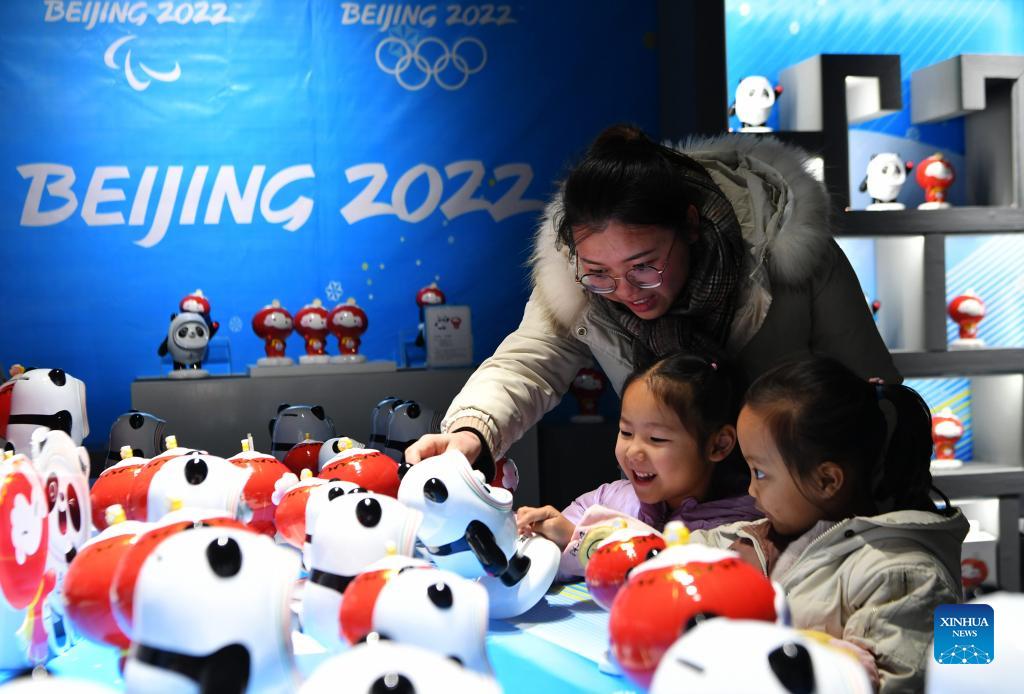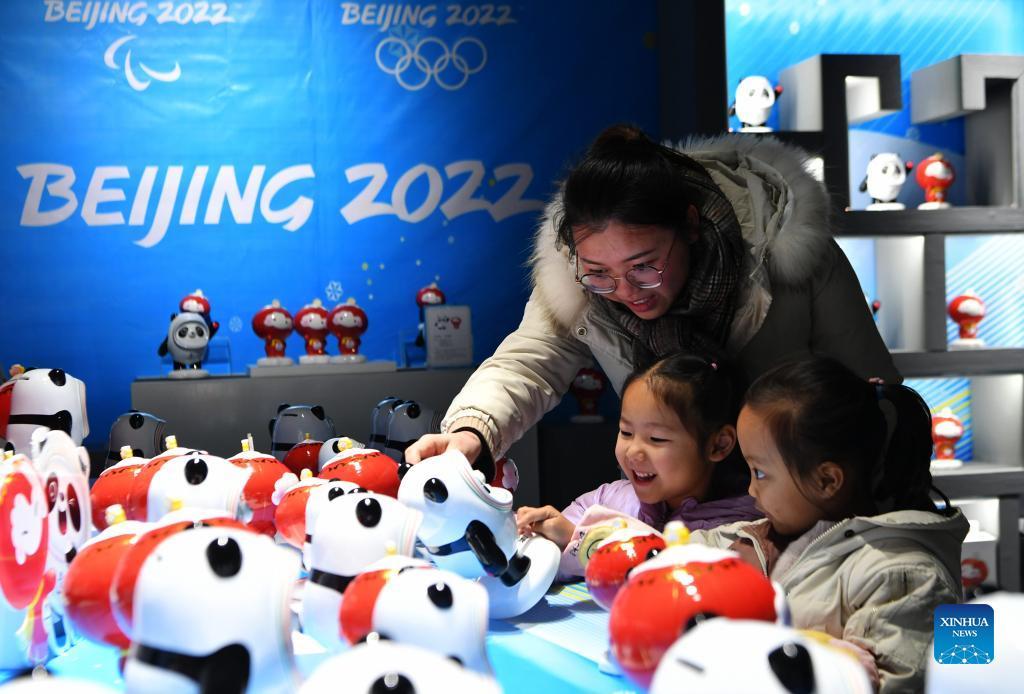
Visitors shop for porcelain figures of Beijing 2022 mascots at a porcelain factory in Dehua County of Quanzhou, southeast China's Fujian Province, Jan. 19, 2022. (Xinhua/Wei Peiquan)
BEIJING, Jan. 25 (Xinhua) -- With the approach of the Beijing 2022 Winter Olympics, the ice-snow tourism season is launched in multiple regions of China at a faster speed, boosting related consumption.
Insiders point out that China can take the Beijing 2022 Winter Olympics as an opportunity to improve related policy system and unleash the great development potential of its ice and snow industry and sports industry.
-- Ice-snow tourism consumption runs high
As the Beijing 2022 Winter Olympics draws near, China enters the best season for ice-snow tourism and witnesses growing enthusiasm for skiing consumption among its residents. According to Fliggy, a tourism service platform, the bookings of trips themed on ice and snow across China have maintained an average weekly growth of 46 percent since December 2021. Ice and snow activities have become the most popular tourism projects this winter in both north and south China.
"The dawning of the Winter Olympics continues to heat up China's ice and snow sports. China is the largest primary skier market in which primary skiers who ski once or twice a year account for as high as 77 percent. Skiing has become the first choice for many tourists to enjoy winter tourism," said Zou Qingling, CEO of lvmama.com, a well-known comprehensive tourism website in China.
Ice and snow scenic spots in regions like Zhangjiakou of Heibei Province, Beijing Municipality, Chifeng and Hulun Buir of the Inner Mongolia Autonomous Region, Liaoning Province, Hangzhou and Shaoxing of Zhejiang Province, Chengdu of Sichuan Province, and Guangzhou of Guangdong Province are bustling with tourists.
Related reception and resort hotels also see soaring reservations. In October 2021, the Lijingwan International Hotel in Beijing formally signed a cooperation agreement with the Beijing Organising Committee for the 2022 Olympic and Paralympic Winter Games. The hotel officially started the reception services for the Winter Olympics on January 4, 2022, and successfully received 108 guests on the first day.
Resort hotels themed on ice and snow also enjoy rising popularity. According to an executive from Tuniu, an online travel agency, the reservations of the hotel plus skiing plus hot spring tourism packages in northeast China soared by 440 percent year on year. The tourists were mainly middle-aged and young people aged between 30 and 40 who prefer leisure vacation. The reservations of ski resort package with 4 nights and 5 days were the highest as the facilities of skiing resort were relatively comprehensive, including entertainment projects like on-snow activities, hot springs, and water world.
Meanwhile, the Winter Olympics is also activating the ice and snow industrial chain. During the Double 11 shopping festival in 2021, the sales of ski products on Alibaba's e-commerce platform Tmall soared by 120 percent year on year. According to data from AliExpress, Alibaba's cross-border e-commerce platform, in the fourth quarter of 2021, the overseas sales of Chinese ski products grew by over 60 percent year on year, with that of ski helmets by 15 times.
As the Winter Olympics dawns, a closed-loop industrial chain of ice and snow producing, rescue, vacation services and supporting facilities has gradually taken shape, and the consumer demand for ice and snow has boosted the concentration and development of the industry and brought new growth engine for consumption, said Liu Yunan, general manager of industrial consulting with KCHANCE, a Shanghai-based travel consultancy.
-- Local ice and snow industry gains momentum
A report on China's ice-snow tourism development released by the China Tourism Academy shows that despite of the COVID-19 epidemic, the ice-snow tourism in China saw tourists jump from 170 million in the 2016-2017 ice-snow season to 254 million in the 2020-2021 ice-snow season, driven by the Beijing 2022 Winter Olympics, the backflow of tourists seeking outbound ice-snow tourism, the upgrading of tourism consumption and the national layout of ice and snow facilities. The number of such tourists is expected to reach 305 million in the 2021-2022 ice-snow season, says the report.
Many regions in China are seizing the opportunity to start the ice-snow tourism season, launching ice and snow vacation projects and tourism routes with local characteristics, and introducing preferential prices.
Dai Bin, president of the China Tourism Academy, said at a forum on the development of China's ice-snow tourism in 2022 held early January this year, that in this ice-snow season with the Winter Olympics, the yearning of urban and rural residents for ice and snow leisure becomes the foundation of tourism consumption.
With the first batch of state-level ice-snow tourism resorts announced by the Ministry of Culture and Tourism not long ago, a diversified and multilevel ice-snow economic system, which integrates sports, culture and tourism and drives by technology, capital and innovation, has taken shape, Dai added.
Critical plans for the sports industry and ice and snow industry are also being implemented at a faster pace.
In October 2021, the General Administration of Sport of China released a plan on the development of the sports industry in the 14th Five-Year Plan Period (2021-2025). It stipulates that by 2025, the total scale of the sports industry reach 5 trillion yuan, with the added value accounting for 2 percent of the GDP, the residents' sports spending exceeding 2.8 trillion yuan, and the number of related employees surpassing 8 million.
The plan emphasizes the leapfrog development of ice and snow sports by taking the opportunity of preparing for the Beijing 2022 Winter Olympics. It also requires to promote ice and snow sports nationwide and engage 300 million people in such sports, and to strengthen related strategic planning and layout and improve the regional development system of the ice and snow industry.
Recently, Jiangsu, Gansu and Yunnan provinces and Shanghai Municipality among others successively released their respective sports industry development plan in the 2021-2025 period.
East China's Jiangsu Province proposed in its plan to bring the total scale of its sports industry to over 720 billion yuan by 2025, with the added value of the industry accounting for more than 2 percent of the province's GDP, the sports consumption of urban and rural residents exceeding 300 billion yuan, the per capita sports consumption reaching 3,500 yuan, and the newly-added sports listed companies recording 3 to 5.
Shanghai has made it clear that by 2025, remarkable achievements should be made in the high-quality development of its sports industry, with the total scale of its sports industry doubling that of 2020.
Insiders believe that the number of tourists for ice and snow tourism in China may exceed 500 million by 2025, with the domestic ice-snow tourism revenue projected to be over 1.1 trillion yuan, accounting for nearly one fifth of that of the whole sports industry, and the outdoor industry of ice and snow sports enjoys a broad market space.
According to Wu Qi, executive director of the Wuxi Institute of Digital Economy based in Jiangsu, with the introduction of both national and local policies, especially the approaching of the Winter Olympics, the software and hardware facilities of ice-snow tourism are continuously improved and the residents' enthusiasm for participation continues to grow, driving China's ice and snow industry to usher in a period of rapid development.
Meanwhile, the residents' consumption has transited from basic and functional consumption to healthy and experience consumption, and ice and snow tourism meets their consumption upgrading demands, heating up related tourism products and promoting the development of the ice and snow industry and the sports industry, Wu added.
-- Industry potential should be better spurred
In the view of insiders, by taking the opportunities brought by the Winter Olympics, related policy system should be further improved to support the innovative development of the ice and snow industry and the sports industry, and promote ice and snow sports events and related education to form more complete industrial chains.
"In the long term, developing ice and snow tourism needs to further strengthen the leading role of science and technology, as well as cultural creativity, develop the night economy, and cultivate cultural and tourism consumption scenes in areas with rich ice and snow resources. Moreover, the ice and snow tourism industry system should be improved. The ice and snow industry is not just about sports venues, and it also needs to plan education, research and development, innovation, planning, consulting, design, investment, equipment manufacturing and other links in the upstream of the industrial chain, as well as venue operation, event management and other links in the downstream of the industrial chain," said Zou Qingling.
According to Wu Qi, the restructuring of demand, industrial transformation and upgrading, accelerated urbanization and the hosting of large-scale events like the Winter Olympics have brought new development opportunities to China's sports industry, and different regions should promote the integrated development of sports, tourism, media, exhibition, film and television and other related industries based on advantages in positions, resources and industries, as well as the service-oriented and market-oriented development of the sports industry.
(Edited by Tong Ting, Gu Shanshan with Xinhua Silk Road, gushanshan.1987@163.com)




 A single purchase
A single purchase









